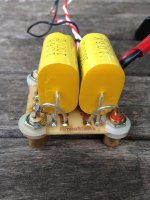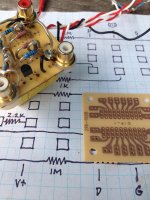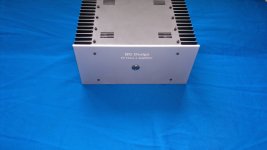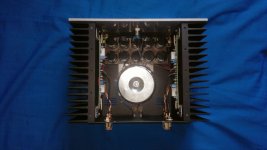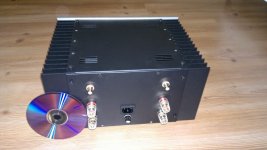Wow.
My post was meant as humor, and having it end up immediately after the post showing the amazing Pass Concept Amplifiers puts that into high relief. Those Concept Amps are....
My post was meant as humor, and having it end up immediately after the post showing the amazing Pass Concept Amplifiers puts that into high relief. Those Concept Amps are....

Very nice F5!
Thank you walter
here is where i bought parts from
i use 10pcs 10000uf 50v rail capacitors
4X New Roe EYH 10000uF 50V 105C 35x40mm Hi End Audio Caps | eBay
i use this pcb boards and those are very good because darwn as symmetrical very easy to construct.
Symmetrical Stereo F5 Amplifiers' PCB Boards 2pcs Hi End | eBay
and those input fets, looks fake but i didnt have any problem with those, works good.
Symmetrical Stereo F5 Amplifiers' PCB Boards 2pcs Hi End | eBay
i hope those would be help
Thank you walter
here is where i bought parts from
i use 10pcs 10000uf 50v rail capacitors
4X New Roe EYH 10000uF 50V 105C 35x40mm Hi End Audio Caps | eBay
i use this pcb boards and those are very good because darwn as symmetrical very easy to construct.
Symmetrical Stereo F5 Amplifiers' PCB Boards 2pcs Hi End | eBay
and those input fets, looks fake but i didnt have any problem with those, works good.
Symmetrical Stereo F5 Amplifiers' PCB Boards 2pcs Hi End | eBay
i hope those would be help
Looks nice, but I'd be concerned about the small size of the heatsinks. Monitor their temperature closely. What bias voltage have you dialed in on those?
Looks nice, but I'd be concerned about the small size of the heatsinks. Monitor their temperature closely. What bias voltage have you dialed in on those?
Thanks stijn001
The bias is about 1.1a , every time a biased my f5 amplifier to the 55deg/C of heatsink, in that way you keep your amplifiar in safe limit whatever your heatsink is (as far as i know Nelson Pass recommend something like that ).
By the why the pictures may be illusive but it has pretty tick heatsink 1.2cm tick wall with 6cm wings.
Thanks stijn001
The bias is about 1.1a , every time a biased my f5 amplifier to the 55deg/C of heatsink, in that way you keep your amplifiar in safe limit whatever your heatsink is (as far as i know Nelson Pass recommend something like that ).
By the why the pictures may be illusive but it has pretty tick heatsink 1.2cm tick wall with 6cm wings.
Very nice, and inspiring 🙂
Where did you get those heatsinks?
Very nice, and inspiring 🙂
Where did you get those heatsinks?
I think it was a radio transmitter made in Japan for radio stations ( there was a Japan brand on it) at the first glance i thought it was an amplifier but there was no RCA input and binding post at the rear panel only two BNC connectors anyway i bought it, when i opened it i saw 6pcs parallel power mosfet, a couple of hard wired coils , 3 or 4 small transistors, a handfull capacitors and very big transformars with 12v must be 300w.
I never pluged it in main supply, instantly i cleaned its inside , drew a front and rear panel in autocad and applied powder coat to them here was my new amplifier's case 🙂
Unfortunately i have never came accross something like that again in whole sellers electronic parts store in Turkey 🙁
in my opinion it was tailored for F5 amplifier , also it could be used as an monoblock apmlifier if there were two of them.
Last edited:
I have finally completed my F5Turbo-X build. Special thanks to Nelson Pass and all forum members supporting and inspiring DIYes out there!
-- xLoff
Amazing, Is there any info about on how to build F5 Turbo-X ?
My Babelfish J Mini (Zen Mod's Aleph J iteration  ).
).
15 watts that kick an *** out of speakers 😀
 ).
).An externally hosted image should be here but it was not working when we last tested it.
An externally hosted image should be here but it was not working when we last tested it.
An externally hosted image should be here but it was not working when we last tested it.
An externally hosted image should be here but it was not working when we last tested it.
An externally hosted image should be here but it was not working when we last tested it.
15 watts that kick an *** out of speakers 😀
The smile in the reflection says all. Good work!!! I also like the font of "Babelfish J mini". What did you choose?
That is very good job acamilicko, The name on the front panel looks classy, i think its done as sand blasting method or lazer etched ?
If i havent sat on the Krell KSA50 , one of the Aleph series was the next project of mine.
Thank you to let us see your work.
If i havent sat on the Krell KSA50 , one of the Aleph series was the next project of mine.
Thank you to let us see your work.
Thank you very much diy brothers 🙂
The font used is Southern Aire
Front panel is done with black 3mm acrylic glass, cut with laser 🙂
Here (on baby diyaudio) are some more images and build process with schematics: Babelfish J mini - Solid State - diyAudio.rs
Thought of some more muscle Alephs, but as I currently live in small apartment, 15W per channel are just fine. I had TDA2030 amp. before this dude, and differences between those chipamp 15 watts and these single end N.P. A class 15 watts are dramatic 😱
Got Visaton CT142 attached to this amp, and this guy really blasts those 60W speakers up to bottom 😎
A class is really class for itself, without a doubt.
The font used is Southern Aire
Front panel is done with black 3mm acrylic glass, cut with laser 🙂
Here (on baby diyaudio) are some more images and build process with schematics: Babelfish J mini - Solid State - diyAudio.rs
Thought of some more muscle Alephs, but as I currently live in small apartment, 15W per channel are just fine. I had TDA2030 amp. before this dude, and differences between those chipamp 15 watts and these single end N.P. A class 15 watts are dramatic 😱
Got Visaton CT142 attached to this amp, and this guy really blasts those 60W speakers up to bottom 😎
A class is really class for itself, without a doubt.
I have even greater respect for your build, now I have seen on the diyaudio.rs site how you did make your frontpanel... wow

@Walter: Thanks man. Acrylic glass is very thankful material for craft and bending 🙂
What Zen wanna say is, I didn't respect the golden A class rule: 1 watt of output power = 1 kg of mass
What Zen wanna say is, I didn't respect the golden A class rule: 1 watt of output power = 1 kg of mass

- Home
- Amplifiers
- Pass Labs
- Pictures of your diy Pass amplifier

